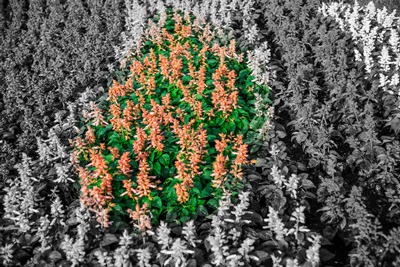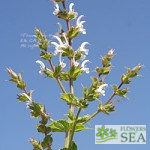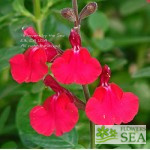Colorful Salvias Break Myth of Dry Garden Drabness

Dry gardens are flowerbeds or entire landscapes based on ornamental perennials that require little to no watering once well rooted. Many Salvias are excellent, drought-resistant choices for these gardens as long as soil drains well, allowing roots to have sufficient oxygen as well as water.
The concept of designing flower gardens that can get by on precipitation alone in semi-arid lands isn’t new, but it didn’t become popular until recent decades as drought returned time and again to the West, Southwest, and states in the high plains steppe like Colorado. It’s appropriate in urban as well as rural settings, particularly in areas that once were undeveloped chaparral or grazing lands.
Myth Breakers in the Garden
Garden writers have published numerous books about dry-climate gardening. We recently reviewed some helpful choices for an article in our Everything Salvias Blog:
- Hot Colors, Dry Garden, by Nan Sterman
- Planting Design for Dry Gardens, by Olivier Filippi, and
- Steppes: The Plants and Ecology of the World’s Semi-Arid Regions by Denver Botanic Gardens staff Michael Bone, Dan Johnson, Panayoti Kelaidis, Mike Kintgen, and Larry G. Vickerman.
The authors of these three books promote understanding of appropriate plants, design, and cultivation for gardening in dry climates. They are myth breakers in the grand tradition of nurseryman and naturalist Theodore Payne (1872 - 1963), who was one of the first horticulturists to defy the notion that dry gardening leads to brown landscapes.
An Early Champion of Dry Gardens
Payne became a gardener early in childhood. Emigrating at 21 to Southern California, he worked in seed houses, managed the country estate of a famous actress, and became an advocate for California's native plants. He opened his own nursery in Los Angeles in 1914 and began developing a specialty in California native plants, including wildflowers. Native plants are among the best choices for dry gardens, because they are acclimated to the amount of precipitation that occurs naturally in their home climate.
That same year, at the California Nurserymen’s convention, Payne gave a presentation on native plants and growing low-water gardens that was published the Pacific Rural Press (Volume 87, Issue No. 1, January 2014). He wrote, “Why not have a dry land garden planted exclusively with native trees and shrubs; no artificial watering would be necessary, the plants depending on the natural rainfall.” Furthermore, Payne noted, “Native flowering perennials could be planted and seeds of annual wild flowers sown....”
Established three years before Payne’s death, the Theodore Payne Foundation for Wildflowers and Native Plants, which is based in the San Fernando Valley, continues to spread his message about sustainability and the beauty of indigenous species. The Foundation's Native Plant Database includes dozens of California Salvias.
But not all dry garden plants need to be native species. What many horticulturists and home gardeners have discovered is that plants from similar climates — even when separated by oceans and continents — can be top choices for color, drought resistance, and sustainability without being invasive.
For example, much of California and parts of coastal Australia, Chile, and South Africa are hot and dry in the summer, then mild and wet in the winter. They are referred to as having Mediterranean climates because their seasons are similar to those of coastal lands surrounding the Mediterranean Sea.
The Xeriscape Movement
One way to think of dry gardening is that it’s a subcategory of xeriscape, which is the practice of designing gardens in which plants are native or adaptable to your dry climate. The xeriscape movement began in Colorado in the early 1980s. Although based, in part, on the Greek word xeros meaning "dry," xeriscape allows for regular, yet infrequent deep watering.
A truly xeric garden, such as Payne advocated, usually doesn’t need supplemental watering once established. However, getting established takes time. How much time depends on the moisture needs of your low-water plantings (there’s lots of variation) and local precipitation patterns.
It can take up to four years to totally turn off irrigation to a dry garden, with watering decreasing significantly in years two and three. When adding new plantings to an established dry garden, you need to spot-water them based on this pattern. Also, gardeners need to remember that even the most xeric of gardens may need irrigation during prolonged drought.
Myths About Dry Gardening
As San Diego garden journalist and educator Sterman explains in the opening of Hot Color, Dry Garden, unfortunate myths persist about xeric design. In particular, she notes the following misconceptions:
Myth #1 - Dry Gardens Aren’t Colorful
There is a rainbow of low-water flowers, including Salvias, that bloom best when water is spare. Also, you can boost color in dry gardens through careful use of painted walls and planters.
Myth #2 - Dry Gardens Look Scraggly
This doesn’t have to be the result if you do a good job of weeding and are careful to choose plants with varying types of foliage and bloom seasons.
Myth #3 - Dry Gardens Are Just Rocks and Cactus
Gravel, rocks, and cactus-family plants — particularly succulents — are important in semi-arid climates. Yet they aren’t the only elements appropriate for dry gardens.
Other incorrect ideas that we would add include:
Myth #4 - Few Kinds of Dry Garden Plants Are Available
At Flowers by the Sea, we grow many Salvias and companion plants that thrive in low-water gardens. These include our extremely xeric blue tag plants. (Blue tags are markers indicating that you need to be careful not to overwater.) At FBTS, we primarily grow plants from the mint-family (Lamiaceae), which is well known for its many genera of drought-tolerant plants, including the huge Salvia genus. Online search terms such as the name of your region, “drought resistant” and “native plants” can help you find many additional dry garden choices.
Myth #5 - Drought-tolerant Plants and Native Plants Don’t Need Watering
As already explained, irrigation is necessary for low-water plants until their roots are well established.
Myth # 6 - Wilting Indicates Underwatering
Sometimes this is true, but wilting often is a sign of overwatering. If roots are waterlogged, they can suffocate. This causes foliage to yellow and droop.
Myth #7 - Bark and Wood Mulch Are Best
Gravel tends to be the best mulch for dry gardening, because it drains well and doesn’t harbor mold that harms plant crowns and roots.
Salvia for Dry Gardens
Here are some suggestions for Salvias to add to your dry garden. We’ve organized them by USDA Plant Hardiness Zones. By the way, most Salvias contain aromatic essential oils that seem to deter deer.
Zone 5
Caucasus Sage (Salvia canescens var. daghestanica)
- Purple flowers bloom May to June
- Velvety, gray-green foliage is mat-forming groundcover
- 12 inches tall and wide in bloom
- Full sun
- Attracts butterflies
Yugoslavian Cut-Leaf Sage (Salvia jurisicii)
- Pale blue-to-violet flowers bloom in summer
- Lacy green foliage
- 10 inches tall and 12 inches wide in bloom
- Full sun
Giant Purple Desert Sage (Salvia pachyphylla)
- Purple flowers with burgundy bracts bloom summer to fall
- Blue-green foliage is evergreen even in snow
- 36 inches tall and 24 inches wide in bloom
- Full sun
- Attracts bees, butterflies, and hummingbirds
Zone 6
Wild Pink Lemmon’s Sage (Salvia lemmonii ‘Wild Pink’)
- Watermelon pink flowers bloom spring to fall
- Veined, mid-green foliage
- 48 inches tall and 36 inches wide in bloom
- Full sun to partial shade
- Attracts bees and hummingbirds
Arctic Blaze Purple Sage (Salvia x ‘Arctic Blaze’)
- Purple flowers bloom spring to summer
- Smooth, mid-green foliage
- 24 inches tall and 36 inches wide in bloom
- Full sun to partial shade
- Attracts bees and hummingbirds
Zone 7
Elk Screamin Scarlet Sage (Salvia x jamensis ‘Elk Screamin Scarlet’)
- Raspberry colored flowers bloom spring to fall
- Deep green foliage
- 36 inches tall and 30 inches wide in bloom
- Full sun to partial shade
- Attracts bees, butterflies, and hummingbirds
Zone 8
Kirstenbosch Golden Sage (Salvia africana-lutea ‘Kirstenbosch’)
- Rusty orange flowers bloom spring to fall
- Woolly, gray-green foliage
- 48 inches tall and wide in bloom
- Full sun
- Attracts butterflies
Pilgrim’s Rest Pink Sage (Salvia dolomitica)
- Lilac and white flowers bloom spring to summer
- Gray-green foliage and burgundy-to-pink calyxes
- 24 inches tall and wide in bloom
- Full sun
Palestine Sage (Salvia palaestina)
- White flowers bloom in summer
- Gray-green, serrated foliage
- 36 inches tall and 18 inches wide in bloom
- Full sun to partial shade
- Attracts bees and butterflies
Zone 9
Cedros Island Sage (Salvia cedrosensis)
- Violet-blue flowers bloom summer to fall
- Fuzzy, silvery foliage
- 36 inches tall and wide in bloom
- Full sun
Blue Ecuadorian Sage (Salvia flocculosa)
- Dusky blue flowers with white beelines bloom summer to fall
- Fuzzy, silvery foliage
- 48 inches tall and 36 inches wide in bloom
- Full sun
- Attracts bees, butterflies, and hummingbirds
Share Your Dry Gardening Experiences
Whether you are accomplished at dry gardening or are just getting started, we’d love to hear about your experiences. Please contact us about your observations and any questions you have about our plants.

 Salvia africana-lutea 'Kirstenbosch'
Salvia africana-lutea 'Kirstenbosch'  Salvia pachyphylla 'Blue Flame'
Salvia pachyphylla 'Blue Flame'  Salvia palaestina
Salvia palaestina  Salvia lemmonii 'Wild Pink'
Salvia lemmonii 'Wild Pink'  Salvia canescens var. daghestanica
Salvia canescens var. daghestanica  Salvia dolomitica
Salvia dolomitica  Salvia flocculosa
Salvia flocculosa  Salvia x 'Arctic Blaze'
Salvia x 'Arctic Blaze'  Salvia x 'Elk Screamin' Scarlet'
Salvia x 'Elk Screamin' Scarlet'  Salvia amplexicaulis
Salvia amplexicaulis  Salvia cedrosensis
Salvia cedrosensis  Salvia jurisicii
Salvia jurisicii
Comments
There are no comments yet.